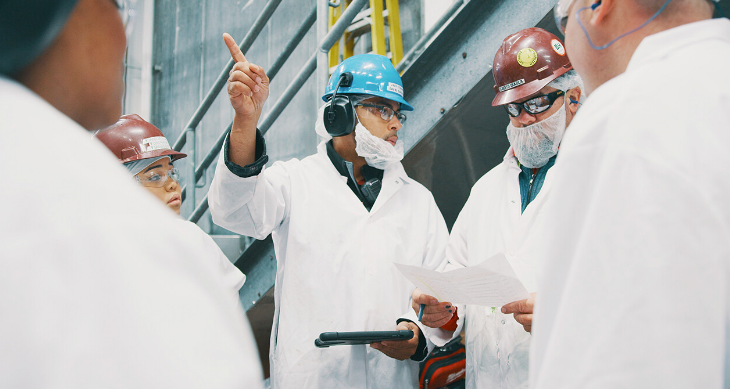Discover the Inspiring Stories from the Faces of the Frontline: Manufacturing's All Stars! Read Now
June 14, 2022

A pre-pandemic report from the Bureau of Labor and Statistics seems like it could have been written last week. It said that manufacturing was losing jobs, and the positions available went unfilled despite steadily rising capacity. Two million jobs were lost from 1980 to 2000, and another 5.5 million disappeared before 2017. Worker demographics were changing. Manufacturing jobs that emerged required higher-skilled workers than ever before. Prime-age workers were conspicuously absent from the factory floor, and older workers were retiring, leaving their positions vacant.
The more things change, the more they stay the same. These issues preoccupy recent news about manufacturing as much as they did in this almost five-year-old report. We might think of the current “labor crisis” as a side-effect of the global pandemic, but the trends in this report suggest they’ve been brewing for decades in the manufacturing sector.
Newly emerging issues further the labor crisis.
We’re looking at two ongoing, but accelerated, trends contributing to the labor crisis in manufacturing:
What new issues deserve attention as they fundamentally shift the landscape in which manufacturers hire, train, and retain workers in the immediate aftermath of the pandemic?
It’s going to mean doing business in new ways and thinking about the needs of a manufacturing workforce using new tools. Want to dive into the labor crisis and learn how manufacturers have used technology to overcome labor shortages? Get our eBook, “Solving Manufacturing’s Labor Crisis with a New Connected Workforce,” and discover the critical ways technology bridges these gaps.
Long-Time Trends in the Labor Market in Manufacturing
1. A Skilled Worker Shortage
In April 2007, an Industry Week article titled “Confronting Our Manufacturing Labor Crisis” wondered whether there were any manufacturing jobs anymore. Author Ralph Keller, who was at the time the president of the Association for Manufacturing Excellence, posed that the shortage was not so much a lack of people, but a lack of skilled workers. American students, he said, just didn’t want to go into manufacturing, and manufacturing itself had evolved to need more highly-skilled, well-paid, trained workers.
In 2007, the industry needed workers who could:
Sound familiar? Fifteen years later, today’s labor crisis remains a skilled labor crisis.
Too often, the current labor crisis is presented as a lack of bodies. But factories are not the centers of rote tasks that they were a century ago. It turns out that while many repetitive tasks have become the domain of robots, jobs for people who can work with new manufacturing technologies have increased.
We still can’t fill these jobs. There have been long-term efforts to recruit more students to see manufacturing as a viable career path. The programs highlighted in that 2007 article all lead to dead links, suggesting that much more robust student outreach will be needed to address the skilled labor shortage.
2. Generational Preconceptions of Manufacturing
Once, baby boomers met manufacturing’s long-time need for workers with their supersized numbers alone. That generation saw little wrong with working for American manufacturing giants, in part because they came of age in an era where American manufacturing prowess was credited with national prosperity. It catapulted generations of unskilled immigrants into the working world, providing them with promising, living-wage careers.
Further, baby boomers grew up playing with the rabbit ears on their television sets and the motors in their restored classic cars. They were a mechanical bunch with plenty of time to tinker.
Later generations did not enjoy this privilege. Technology kept them indoors with joysticks and video games. They likely heard that manufacturing would be moved overseas by the time they were ready for jobs, so they focused on newer technologies like the computers they had right in their homes. As a result, the manufacturing industry began to look old-fashioned and unappealing to this new millennial generation.
In 2005, the state of Michigan, fed up with manufacturing’s reputation as a suitable career for an older generation, developed a program to attract millennials to its ranks. It used black and white pictures of Ford’s first assembly lines but quickly introduced images of a factory built just three years before.
The message was: manufacturing is opening new factories for a new generation. The goal, according to state officials, in a Lansing State Journal article from September 29, 2005, was to convince teenagers that manufacturing was still state-of-the-art. Acknowledging that many young people were uninterested in manufacturing, the Michigan Department of Labor and Economic Growth director said, “most people associate the industry with outdated Hollywood images of the factory line in dark and dirty conditions.” To assure students that manufacturing was a viable career, Michigan’s website also listed salaries for current job openings.
Fast forward to today. Millennials still seem to be the best hope for replacing retiring baby boomers since they outnumber generation X and the zoomers. But manufacturing executives are still worried they aren’t interested in manufacturing careers.
Inspiring millennials to see manufacturing in their image remains a core challenge in solving the labor crisis. The pandemic has only exacerbated this ongoing issue, reinforcing to young people that “desirable” jobs are computer-based and remote.
Old Trends, New Approaches

Manufacturing needs skilled workers and to attract a new generation to its ranks. These problems aren’t new. But as our old approaches to them stall, we need new ways of training existing workers and reaching out across the generations to new ones. For ideas about how to bring high-tech training to the factory floor and engage young workers with the technology they use every day, download our eBook, “Solving Manufacturing’s Labor Crisis with a New Connected Workforce.” It offers ways to overcome these issues and reap the benefits of a connected labor force into the future.
1,000 Factories’ Productivity Data: The Largest Dataset of Its Kind ...

Contact us and let's begin empowering your frontline and growing your bottomline.
